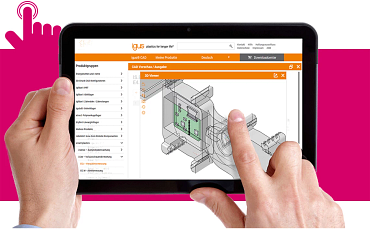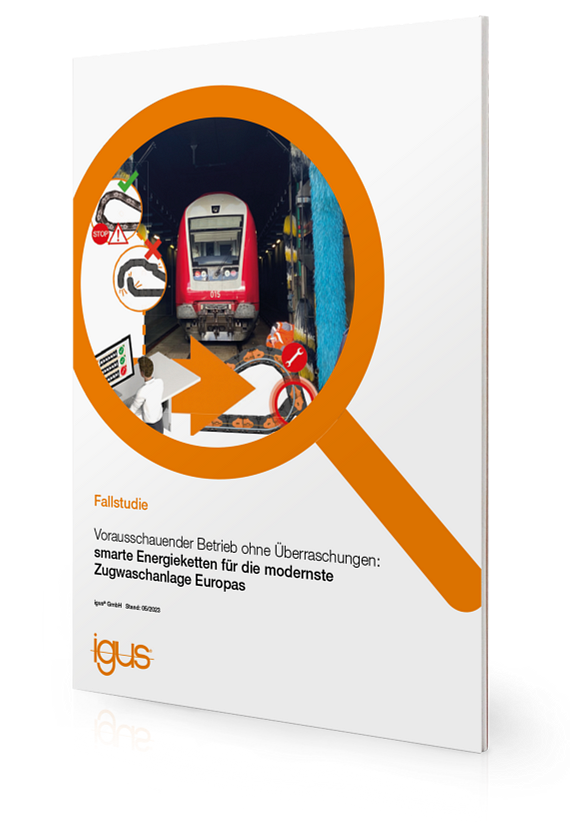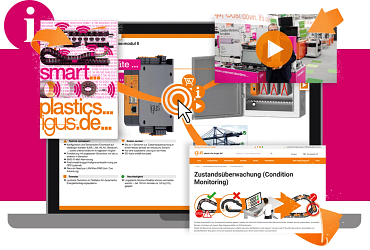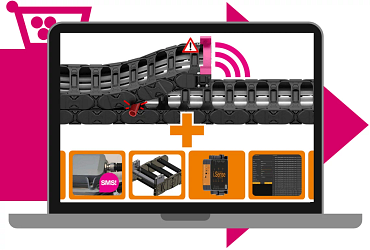Predictive maintenance: definition, benefits, examples ... all with one click!
All questions and answers regarding predictive maintenance with igus®

General
Predictive maintenance is generally understood to mean the early anticipation and avoidance of an error in machinery or components thanks to data on their condition. This is possible with data-based methods that analyse the condition of your machines and help predict malfunctions, faults and also the time when maintenance work is required.
Industry 4.0 promises greater efficiency in production through networked machines, insights due to data analyses and better machine availability. In this context, predictive maintenance, i.e. a forward-looking maintenance process based on the evaluation of process and machine data, is a crucial component.
Unplanned downtime of production equipment costs money and cuts your profits significantly in the long run. What is certain is that machine and system failures pose a serious threat to the industrial sector. Predictive maintenance is intended to lead to cost savings compared to routine, interval- or time-based preventive maintenance as work is only carried out when necessary.
First of all, you need various sensors to record functionally relevant data on the machines, such as speed, temperature, noise level, bearing vibrations or power consumption. After that, a combination of real-time analysis technology and a database is required for the interpretation and meaningful evaluation of the sensor data. If all this is successful, it will be possible to fix the machine problem before it actually arises.
No; predictive maintenance is not only interesting for the manufacturing industry or associated MRO areas (maintenance, repair and operations), but also for all mobility offers - be it in the air, in vehicles or on rails. It is usually worthwhile for companies that use the same type of machine more often or that do not want to use predictive maintenance for their own production but for the machines they sell.
Advantages of predictive maintenance
The advantages and added values for companies can be quickly summarised:
- Higher availability of the systems due to less downtime
- Maximisation of plants' and machines' service life
- Optimised deployment of maintenance technicians
- Scheduled maintenance time
- Higher machine performance and productivity
There are, of course, the one-time investment costs in sensor hardware and software for data analysis and evaluation. In addition, every new method means initial change and training costs. With the ready-to-install smart plastics solutions from igus i.Cee, however, these can be reduced to a minimum.
Between 50 and 70% less unplanned downtime should be possible as well as savings of 20 to 40% maintenance costs - depending on which study by the two renowned consulting firms McKinsey or Accenture you prefer to trust. In addition, Roland Berger claims to have discovered that with predictive maintenance, only 15% of the time is spent on maintenance, compared to 40% with conventional reactive maintenance.
According to the authors of a survey that Bearing Point, another technology consultancy, conducted among experts in maintenance, production, logistics and IT, over 80% of users expect predictive maintenance to increase plant availability, i.e. OEE.
Requirements for predictive maintenance
The collection and analysis of machine data is essential for this type of intelligent maintenance work. With the help of the data, it is possible to calculate the optimum time for maintenance so as to avoid disruptions. Machine data is usually collected via sensors attached to the machine or plant component, often appropriately referred to as predictive maintenance sensors. With the igus energy chains, this task is carried out by the i.Sense condition monitoring sensors from smart plastics. This smart sensor technology continuously records the various operating states of the energy supply.
The prerequisite for an accurate indication of the trouble-free operation time is that information on use is as precise as possible. This includes information about the operation site with weather conditions and temperatures, travel distances, number of cycles etc. Thanks to the knowledge acquired in the igus test laboratory and the current status data, igus is able to precisely predict the life data. The necessary replacement of a component is then displayed in good time and enables scheduled and resource-conserving maintenance.
The prerequisite for predictive maintenance is that the machines are networked, i.e. all machines provide their data in a database for storage and analysis. This is mostly carried out with an OPC UA protocol. However, with the igus i.Cee solutions for predictive maintenance, no additional systems or hardware are required. All necessary data is provided via the associated i.Sense sensors, and the special AI algorithms are implemented in the i.Cee module. The associated i.Cee dashboard can be accessed with any ordinary PC.

Application areas of predictive maintenance
► What examples of predictive maintenance are there in practice?
In practice, it often makes sense to use predictive maintenance with machines where a breakdown would mean high sales losses or consequential damage. Modern machines are often already equipped with the necessary measuring sensors, older ones can be retrofitted.
Here are a few examples:
- Vibration measurements on systems provide information about imbalances, incipient bearing damage etc.
- Temperature measurement systems provide information about bearing damage or cooling problems.
- Measurements of the power consumption of pumps, motors etc. indicate sluggish drives, couplings etc.
- Measurements of the transmission properties of data cables shed light on the remaining service life.
- Force or load cell sensors help determine the current utilisation.
► In which industries does predictive maintenance make the most sense?
Predictive maintenance is primarily used in industries in which the failure of systems, machines or components means significant consequential damage and failure costs:
- Aviation: airlines use sensors in their machines to replace wear-resistant parts, such as turbines or pumps, in good time and to avoid downtime on the ground.
- Automotive: automotive companies operate some of the largest robot fleets in the world, produce just in time and have tightly integrated supply chains. Any problem in production, such as an unplanned downtime, disrupts the entire supply chain.
- Wind turbines: today, vibration analyses can prevent failures of wind turbines almost entirely.
- Ports: the failure of cranes means long waiting times for ships and less throughput for ports.
Operation without surprises: smart energy chains for the most modern train washing station in Europe
Free case study
- How exactly are failures prevented?
- Which components were to blame for the failure?
- How was the whole project approached and with what tools ?
- And how is it going at the moment?
Other maintenance strategies
In its DIN EN 13306, Terms of Maintenance, the Deutsches Institut für Normung e.V. (German Institute for Standardization) defines a maintenance strategy as a procedure for achieving maintenance goals, such as maintaining a specified condition or extending a machine's service life. A distinction is usually made between the following three different approaches:
- Reactive maintenance strategy/damage-based maintenance strategy
- Prophylactic maintenance strategy/preventive maintenance strategy
- Anticipatory maintenance strategy/predictive maintenance strategy
With the reactive form of maintenance, damage to machines is repaired and production parts are replaced only when there is an acute problem. This means that companies have to react quickly in the event of damage in order to be able to continue production as quickly as possible and avoid high downtimes and costs. Most often, this strategy is used with machines that don't need to be repaired often or that can be repaired or replaced cheaply.
Preventive maintenance is a maintenance strategy in which maintenance measures are carried out at specific intervals. The intervals can depend on time or quantity. This means that people don't wait for systems or machine parts to break down, but carry out systematic preventive inspections and maintenance measures. In this case, the actual degree of wear and tear of the machines and systems is not relevant. That procedure is in complete contrast to predictive maintenance: here, process and machine data is recorded during operation via sensors and interfaces, stored and then analysed.
Download more material
In our short guide on increasing machine availability (OEE), you will find all the details for further reading:
You are welcome to take a look at all the available solutions directly in our igus online shop.
In our smart plastics brochure, we give you a complete overview of the igus product portfolio for Industry 4.0.
... Try it ...



